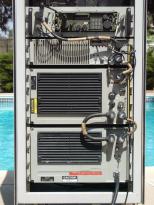
Other members of the Regency Net system include the AN/GRC-215 manpack and the AN/GRC-215 Team Terminal, which consists of a GRC-215 manpack, crypto gear, a data terminal and other equipment which are all mounted in a frame and then installed in a CUCV truck.
Technical information for the Regency Net system is hard to come by, so this page will be very light on details. I believe that a complete AN/TRC-179 includes three of the transmitters shown here along with a lot of other equipment, and is housed in an S-280 communications shelter. I’ve seen references to the Regency Net system components being made by Magnavox and/or Elmer.
2012/11/25 Update: I have received an email from an employee at the plant that made some of the components of this set, confirming that they were made by Elmer! Here is what he had to say:
Starting from below part, Power Supply, Power Amplifier and Post Selector has been designed and assembled in my plant, Pomezia close to Rome. At that time, name of the Company was ELMER S.p.A., after some years, now is part of Finmeccanica. Just the radio is unknown to me.
[…]
I think in the old time We got a project with Magnavox, so most probably was a kind of sharing equipments to get a single system.
I don’t have a list of all of the components of an AN/TRC-179 Force Terminal, but these are the components which are pictured here, and which I have determined are the minimum set of components to construct one complete high-powered SSB transceiver based on this system:
- Receiver-Transmitter RT-1512/G
- Controller, Rcvr/Xmtr C-11670/G
- Tuning Unit, Pre-Post Selector TN-612/G
- Amplifier, Power AM-7296/G
- Power Supply PP-8097/G
It took me several years to gather all of these components and the cables necessary to connect them together, and then I traded the whole set away shortly afterwards! :-)
I’ve seen the AM-7296/U power amplifier referred to as a 400W amplifier. I measured the following power outputs when transmitting into a dummy load and blowing into the microphone:
| Mode | Measured PEP Output |
|---|---|
| Low Power | 16W |
| Medium Power | 60W |
| High Power | 300W |
Although the system has the same kind of audio connectors as other Vietnam-era and later US equipment, it doesn’t use all of the same audio accessories. It uses the H-356 handset, which looks just like the common H-250 handset but has a different connector pinout. In the H-356, the microphone ground connection is moved from pin A to pin E:
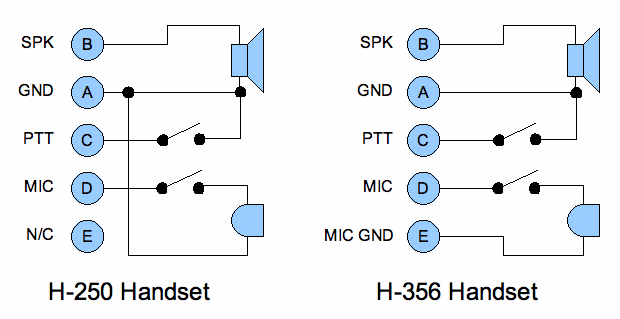
I have a number of test sets for the Regency Net system, which are pictured below. It’s not a complete set, and what I have is a mixture of test sets for the AN/TRC-179 and the AN/GRC-215 systems.
Pictures
System mounted in commercial 19″ equipment rack:
Receiver-Transmitter RT-1512/G:
Controller, Rcvr/Xmtr C-11670/G:
Note the missing ECCM module (between the power regulator and CPU-I/O slots), and the reversible plate which indicates whether or not it is installed.
Tuning Unit, Pre-Post Selector TN-612/G:
Amplifier, Power AM-7296/G:
Power Supply PP-8097/G:
Test Set TS-4245/G for RFO (?)
Test Set TS-4255/GRC-215 for Manpack
Test Set TS-4248/G for Power Supply
Test Set TS-4249/GRC-215 for 100W Power Amplifier
Test Set TS-4252/GRC-215 for Vehicle Adapter
Dummy Load DA-727/G
Miscellaneous:
I have not yet obtained an power input cable or the proper power input plug for the PP-8097/G power supply, so I have temporarily spliced in power by dismounting and capping off the power input plug (a 4-pin plug from Souria’s 840 series), mounting a cable clamp in the hole, and alligator-clipping a line cord onto the main breaker. This can be easily reversed if and when I get the correct plug, or I could make it semi-permanent by soldering the line cord onto the breaker’s terminals.
A small fork-shaped piece on the back of the main breaker’s lever was broken. I fabricated a replacement out of some tool steel stock in order to get the set up and running.
Here are test meter readings during my first smoke test. Everything looks good!
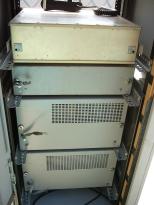
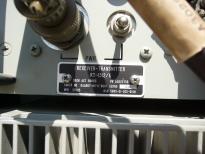
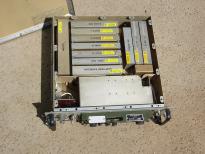
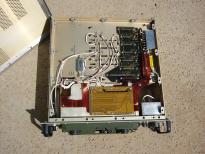
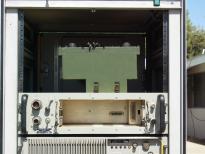
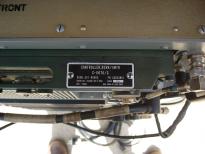
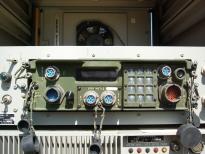
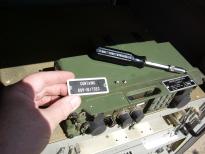
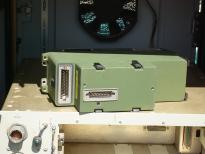
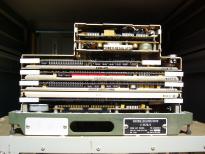
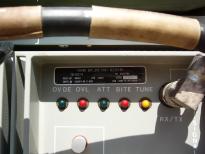
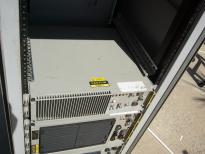
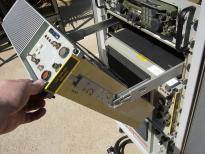
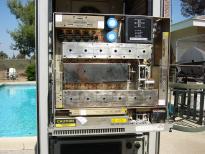
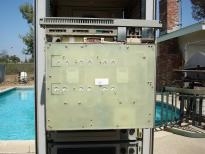
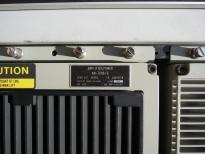
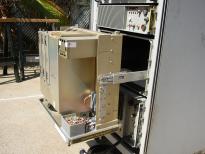
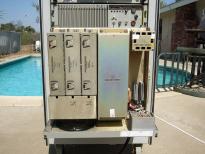
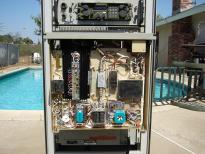
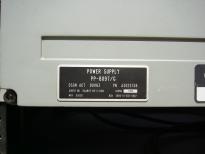
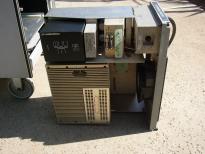
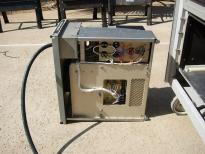

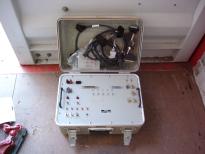
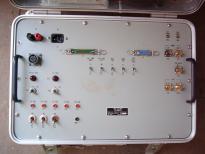

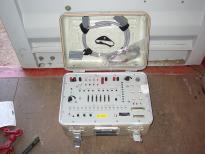
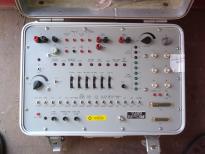

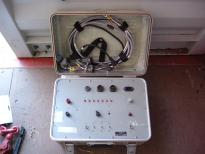
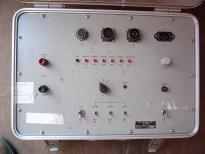

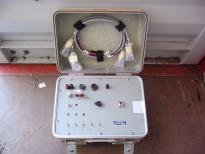
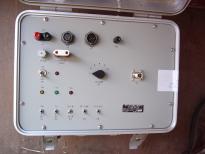


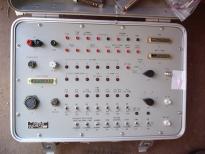

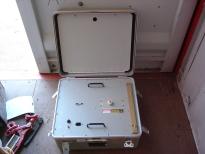
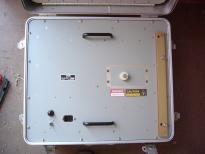
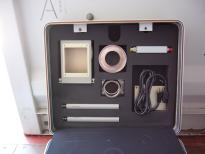
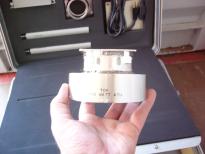
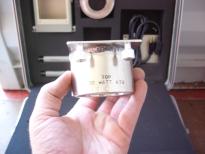
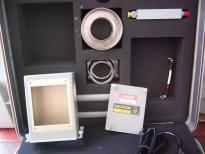
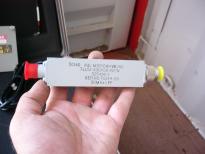

















I have one of the dual amplifier’s (80063 ASSY A3026013) used in the AM-7296/G Amplifier. I’d like to use it to amplify a QRP signal on the Ham Bands. Do you have any idea what kind of input power level is needed to drive it?
Thanks,
Roger KL7Q
The RT-1512 receiver-exciter’s nominal output is 100mW PEP according to its TM. Its signal passes through the TN-612 pre/post-selector before going to the power amplifier, and the TN-612 is supposed to add about 10dB of gain in Tx mode. I don’t have my Regency Net hardware any more, so I can’t make any measurements. I also don’t have an AM-7296/G TM, so I can’t look up its specs. Based on the limited TMs I do have, I think that the AM-7296/G probably expected about 1W PEP input.
Hello, I have a very similar system. we are looking for manuals or any other kind of documentation. eventually you have some manual, pdf and/or information you might share with us. That would be awesome. =)
Yours sincerely
quest
Hi!
Sadly, I don’t have manuals for this system other than the ones that are already available online. I never found most of the manuals before I sold this set to another collector. I hope that you have better luck than I did!
Hello,
I have some RT-1512/G but I do not have any information about these receiver/exciters. Does anyone know how you have to use the control panel from the C-11670/G?
When I switch the RT-1512 on it passes a self test. This self test fails. I do not know why. When I enter a Frequency it receives and I can change the sidebands.
Pushing the PTT does not produce an output signal!?
Can you please help me?
´73
Manfred
DL6ZBG
Hi. If a self-test is failing, then that may explain why you don’t see any output signal. Keep in mind that it is a SSB transceiver, so there will not be any significant output signal without an audio signal into the radio. Unless you have one of the rare (?) microphones made for this system, then you will need to rewire a handset to work with the radio. The microphone circuit is wired differently, so a common handset with a matching plug will not provide any audio to the radio. By itself, I think that the RT-1512/G only produces around 100mW of radio signal.
TN-612 manual here: http://www.liberatedmanuals.com/TM-11-5895-1305-24.pdf
Do you know where I might find schematics for the manpack components? I found the 24 series manuals for most components on Radionerds but no schematics.
I’m sorry, but I have not encountered schematics for the manpack parts. I hope that you manage to find them.
Hi Mark:
The TCI-651T antenna was used on this system. It’s rated for EMP. Everything is shorted at DC.
http://prc68.com/I/WireAntenna.shtml#TCI651T
73,
Brooke Clarke, N6GCE
In addition to the EMP survivability, the big push behind RN (Regency Net) was to get to HF Digital Communications capability. As Mark points out, RN was a EUCOM system used in Europe. It was West Germany, at the time (FRG), which is about the size of Oklahoma, but also included Italy, Turkey & Greece, which is too large for reliable Ground Wave coverage and too small for effective (reliable) skywave – especially at night and EXTRA especially if you are trying to use voice grade SSB. There was a big competition between a Team led by Harris Corp (now L-3 – Harris) and Hughes Aerospace / Magnavox. Hughes won the development contract, even though Harris probably had a superior system approach. RN replaced a ‘system’ known as Cemetery Net, which was just an HF SSB Voice net using primarily (the old) Collins S-Line equipment in both fixed (Console with dipole antennas) and mobile (S-280 shelter and a Whip antenna) node configurations. In case anyone is wondering, the RN had really only one mission, and that was the Command and Control of the Nuclear Weapons that EUCOM had in Europe at that time.
73,
Rich Mouldin, ex K4CDT; Cemetery 123 (ret.)
Thanks for filling in some details!
I live in Northern California and for the past few years there’s been a major forest fire very near me. The ionized gases that come with fire are electrically conductive and has caused the breakers to blow on electrical transmission towers. Also PG&E shuts off the AC mains when they worry that a line will be blown down and start a fire. When the AC mains go down that has the cascading effect of taking out cell towers, Cable TV/internet, Wireless Internet. Some cell towers were lost because the fire got to them. But my DSL account still works because it’s regulated under FCC Title III. Note that no government has declared the internet a vital utility that should work in an emergency. Because of that lack there’s no requirement for backup power for ISPs, cell providers, WISP and ISPs in general. Note that VOIP phone service quits when the power fails. The only reliable phone service is that delivered on copper wires. In that case emergency communications were by ham radio on 2 meters where we have a county wide simplex net.
It’s easy to imagine a case where the 2 meter system will work in some locations, but there will be a lack of longer range coms. that’s where I think there’s still a need for NVIS HF coms.
73,
Brooke Clarke, N6GCE
I couldn’t agree more Brooke. I’m a EE (got there through Ham Radio as a kid) I took a ROTC Commission in 1970 and served in Germany in two different Nuclear weapons systems, one where ‘fixed’ (Console with dipole antennas) would work and one that required mobile (portable in Ham Radio) (S-280 shelter and a Whip antenna). Of course fixed installations could (and sometimes were) backed up by Tropo (big towers, Space Diversity antennas) but in general, HF was really the only way to go for mobile OTH communications. As I said above, this was critical Comms system for the command and control of Nuclear Weapons (NuC-3). So my experience in Europe combined with of my Ham (HF) and EE (I had a Comms major – not power or circuits) taught me what was really needed. I was on the Harris team (reference my post above) and we had a brilliant system solution that we called flooding, and it used (and required) both NVIS and GW and could be enhanced with (long-haul) sky-wave.
73,
Rich – “Central Daylight Time”